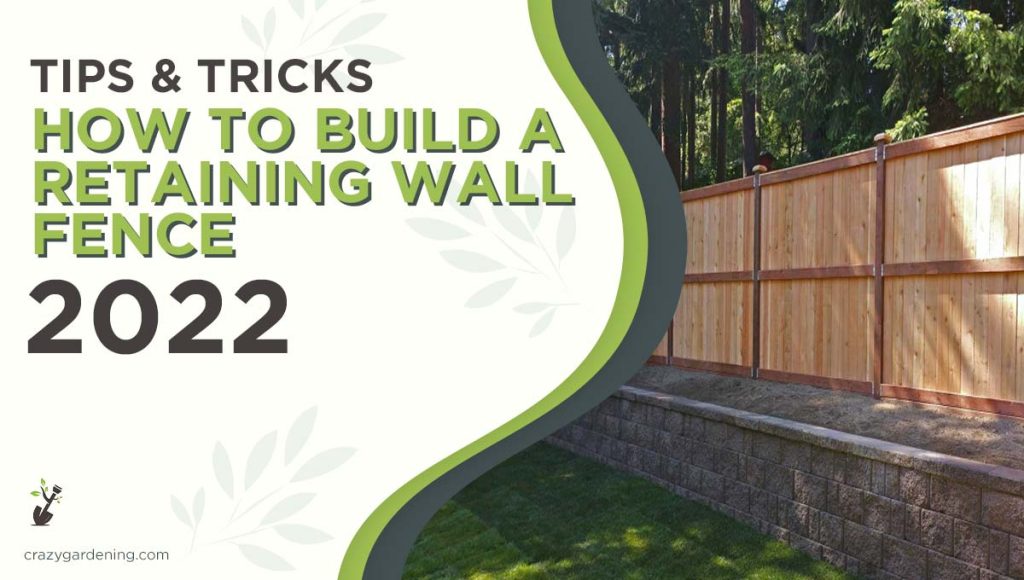How to Build a Retaining Wall Fence Like a Pro [Hacks 2025]
If you have ever tried to garden on a slope, you know that it can be a real challenge.
It’s difficult to build a fence on a slope and trying to keep soil and plants from cascading down the incline is virtually impossible. But with a retaining wall fence, you can easily solve this problem.
Not only does a retaining wall fence add visual appeal to your landscape, but it also helps to stabilize the ground and prevent erosion.
In this article, we will show you how to build a retaining wall fence using railroad ties or timber logs.
What is Meant by Retaining Wall?
A retaining wall is a structure that is built to support soil or rock on one side while resisting the pressure of the backfill material on the other side. It can be used for residential, commercial, and industrial applications.
There are many different types of retaining walls, but the most common is the gravity wall.
Gravity walls rely on their own weight to resist the pressure of the backfill material. Other types of retaining walls include cantilevered walls, crib walls, and buttress walls.
Why Do You Need a Retaining Wall Fence?
Safety Above The Wall
If you have a sloped yard, then you know how difficult it can be to keep plants and soil from washing away.
A retaining wall fence can help to stabilize the ground and prevent erosion. It can also be used to create level gardening areas on a slope.
A Unique Wall Fence
In addition, a retaining wall fence can add visual appeal to your landscape. There are many different types of materials that you can use to build your fence, so you can find one that fits your style and budget.
Added Security
Another reason to build a retaining wall fence is for security. If you have a pool or other water feature, a retaining wall fence can help to keep children and pets safe.
It can also be used to create a barrier around a garden or other area that you want to keep away from foot traffic.
Privacy For Your Property
If you live in a neighborhood with close houses, a retaining wall fence can provide you with the privacy that you desire. By building a high fence, you can keep nosy neighbors from looking into your yard.
What Type of Fences Can You Build with Retaining Wall?
Surface Mounted Fence
One of the most common types of retaining wall fences is the surface-mounted fence. This type of fence is attached to the face of the retaining wall with brackets or hangers.
The advantage of a surface-mounted fence is that it is easy to install and does not require any special tools.
Face Mounted Fence
Another type of retaining wall fence is the face-mounted fence. This type of fence is attached to the back side of the retaining wall with brackets or hangers.
The advantage of a face-mounted fence is that it is more stable than a surface-mounted fence.
Embedded Fence
Another type of retaining wall fence is the embedded fence. This type of fence is built into the retaining wall itself. The advantage of an embedded fence is that it is very strong and stable.
Post-in System Fence
The last type of retaining wall fence is the post-in system fence. This type of fence is attached to the face of the retaining wall with brackets or hangers.
The advantage of a post-in system fence is that it is easy to install and does not require any special tools.

How to Build a Retaining Wall Fence?
Building a retaining wall fence is not as difficult as it may seem. With the right materials and tools, you can easily build a fence that will last for years.
Gather Needed Tools and Materials
The type of material that you use for your retaining wall fence will depend on the look that you want to achieve and the function that it needs to perform.
For example, if you are looking for a decorative fence, then you might want to use bricks or stones.
If you need a functional fence that will withstand heavy rains, then you might want to use railroad ties or timber logs.
No matter what type of material you use, you will need to have the following supplies on hand:
* Retaining wall blocks or bricks
* String line level
* Trowel
* Shovel
* Wheelbarrow
* Tamper
* Concrete mix
* Posthole digger
* Posts (wood, metal, or PVC)
* Gravel
* Landscape fabric
* Construction adhesive (optional)
Step 1: Plan Your Fence
The first step in building a retaining wall fence is to plan your fence. You will need to decide on the location, height, and length of your fence.
It is also important to take into account the type of soil and the amount of rainfall that you get in your area.
Step 2: Excavate The Area
Once you have planned your fence, you will need to excavate the area where it will be built.
If you are using retaining wall blocks or bricks, you will need to dig a trench that is twice as wide as the blocks and at least 6 inches deep.
If you are using railroad ties or timber logs, you will need to dig postholes that are at least 2 feet deep.
Step 3: Install The Drainage Pipe
After you have excavated the area, you will need to install a drainage pipe. This pipe will help to prevent water from building up behind your fence and causing it to collapse.
To install the pipe, you will need to dig a trench that is 4 inches wide and 8 inches deep. Then, place the pipe in the trench and fill it with gravel.
Step 4: Set The First Course Of Blocks Or timbers
Once the drainage pipe is in place, you can begin setting the first course of blocks or timbers. If you are using retaining wall blocks, you will need to spread a layer of concrete mix in the bottom of the trench.
Then, place the blocks in the trench and tap them into place with a trowel. Be sure to check that the blocks are level as you go.
If you are using railroad ties or timber logs, you will need to set them in the postholes. Then, fill the postholes with concrete.
Step 5: Continue Adding Courses
Once you have set the first course of blocks or timbers, you will need to continue adding courses until your fence is the desired height.
Be sure to check that each course is level as you go. You may also want to use construction adhesive to secure the courses in place.
Step 6: backfill The Area
Once your fence is the desired height, you will need to backfill the area around it. Be sure to use gravel in the bottom of the trench to help with drainage.
Then, fill the rest of the trench with soil and tamp it down. You may also want to add a layer of landscape fabric to help prevent weeds from growing.
Step 7: Attach The Fencing Material
The last step in building a retaining wall fence is to attach the fencing material. If you are using chain link or wooden slats, you will need to tie them onto the posts.
If you are using wire mesh, you will need to staple it to the posts. Once all of the fencing material is in place, you are finished!
How to Build a Retaining Wall on a Slope?
Building a retaining wall on a slope requires careful planning and execution to ensure stability and effectiveness. Here are the general steps for building a retaining wall on a slope:
1. Determine the location and size of the retaining wall, and obtain any necessary permits.
2. Mark the area where the wall will be located, and excavate the slope to create a level base for the wall.
3. Install a drainage system behind the wall to prevent water buildup and pressure.
4. Place the first layer of blocks or stones at the bottom of the slope, using a level to ensure proper alignment.
5. Build subsequent layers of the wall, making sure to stagger the blocks or stones for stability.
6. Backfill the area behind the wall with gravel or crushed stone to promote drainage.
7. Finish the top of the wall with capstones or a coping material.
Cautions
Be sure to check with your local building code office to see if you need a permit to build a retaining wall fence.
Also, be sure to have a professional inspect your work before you backfill the area. This will help to ensure that your fence is safe and up to code.
Conclusion
Building a retaining wall fence is a great way to add privacy and security to your home. It can also be a great way to improve the look of your property.
However, before you begin, it is important to choose the right materials and plan your fence carefully. With a little bit of planning and effort, you can build a beautiful and functional fence that will last for years to come.
FAQs
Question
Can You Put a Retaining Wall Against a Fence?
Answer
Yes, you can put a retaining wall against a fence. however, you will need to make sure that the fence is sturdy enough to support the weight of the wall. You may also want to use construction adhesive or metal brackets to secure the wall in place.
Question
How close to a retaining wall can I build a fence?
Answer
At least 3 feet away from a retaining wall should be safe. Any closer and you run the risk of the fence putting too much pressure on the wall and causing it to collapse.
Question
How do I stop my neighbor’s fence from leaning on my retaining wall?
Answer
If your neighbor’s fence is leaning on your retaining wall, you can try to talk to them about it. If they are unwilling to fix the problem, you may need to hire a lawyer or take legal action.
Question
Why is my retaining wall leaning?
Answer
There are several reasons why a retaining wall might lean. The most common reason is that the ground behind the wall is not level. This can cause the wall to shift and lean over time. Another common reason is that the wall was not built properly.
Question
How do you attach a fence to a retaining wall?
Answer
To attach a fence to a retaining wall, use a sleeve anchor or wedge anchor to secure a post bracket to the wall. Then, attach the fence post to the bracket.
Question
What is the cheapest way to build a retaining wall?
Answer
The easiest way to build a retaining wall is to use interlocking blocks or stones, which can be stacked and secured without the need for mortar or complex construction techniques.
Question
What’s the easiest way to build a retaining wall?
Answer
Yes, it is possible to build a retaining wall yourself if you have the proper tools, materials, and knowledge. However, it may be safer to hire a professional for larger projects.

